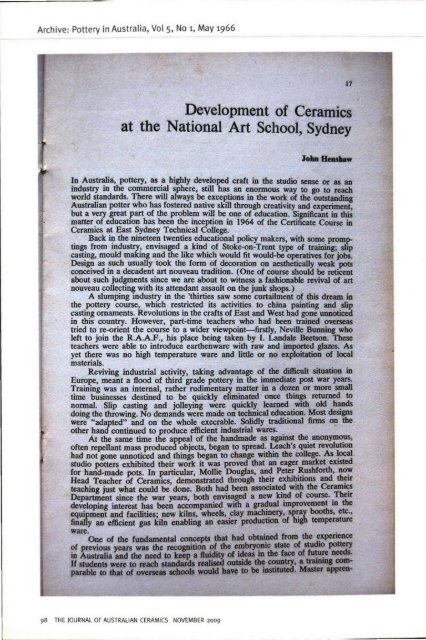The Journal of Australian Ceramics Vol 48 No 3 November 2009
You also want an ePaper? Increase the reach of your titles
YUMPU automatically turns print PDFs into web optimized ePapers that Google loves.
Archive: Pottery in Australia, Vo l 5, <strong>No</strong> 1, May 1966<br />
Development <strong>of</strong> <strong>Ceramics</strong><br />
at the National Art School, Sydney<br />
17<br />
,...9 ' w<br />
In Australia, pottery, as a highly developed craft in the studio sense or as 8D<br />
industry in the commercial sphere, still has an enormous way to go to reach<br />
world '!aDdards. <strong>The</strong>re will always be. exceptions in the work <strong>of</strong> the outstaDdinl<br />
<strong>Australian</strong> potter who has fostered native skill throuab creativity and experiment,<br />
but a very great part <strong>of</strong> the problem will be one <strong>of</strong> ~tion . Sipificant in Ibis<br />
matter <strong>of</strong> education has been the inception in 1964 <strong>of</strong> the Certificate Course in<br />
<strong>Ceramics</strong> at East Sydney Technical College.<br />
Back in the nineteen twenties educational policy makers with some promptings<br />
from industry, envisaged a kind <strong>of</strong> Stoke-on-Trent tYPe <strong>of</strong> trainina' &lip<br />
cast!ng, mould malcing and the liIce which would ~t would-be operatives for 'jobs.<br />
Design as such usually took the form <strong>of</strong> decoration on aesthetically weak pots<br />
conceived in a decadent art nouveau tradition. (One <strong>of</strong> course should be teticcnt<br />
about such judgments since we are about to witness a fashionable revival <strong>of</strong> art<br />
nouveau collecting with its attendant assault on the junIc shops.)<br />
A slumping industry in the 'thirties saw some curtailment <strong>of</strong> Ibis dream in<br />
the pottery course, which restricted its activities to china painting and &lip<br />
casting ornaments. Revolutions in the crafts <strong>of</strong> East and West had gone unnoticed<br />
in Ibis country. However, part-time teachers who had been trained 0YCne8S<br />
tried to re-orient the course to a wider viewpoint-firstly, Neville BVDDina who<br />
left to join the R.A.A.F., his place being taken by I. Landa1e Beetson. <strong>The</strong>se<br />
teacbers were able to introduce earthenware with raw and imported glazes. As<br />
yet there was no high temperature ware and little or DO expIoitatioa <strong>of</strong> 10caI<br />
materials.<br />
Reviving industrial activity, talcing advantage <strong>of</strong> tbe difIicult situatioo in<br />
Europe, meant a flood <strong>of</strong> third grade pottery in the iD1mediate post war years.<br />
Training was an internal, rather rudimentary matter in a dozen or more unaII<br />
time businesses destined to be quickly eliminated once ~ returned to<br />
normal. Slip casting and jolleying were quickly teamed with old bands<br />
doing the throwing. <strong>No</strong> demands were made on tecImicaI educatioa. Most designs<br />
were "adapted" and on the whole execrable. Solidly traditiooal firms OIl tbe<br />
other band continued to produce efficient industrial wares.<br />
At the same time the appeal <strong>of</strong> the handmade as against the anonymous,<br />
<strong>of</strong>ten repellant mass produced objects, began to spread. Leach's quiet revolution<br />
bad not gone UDDoticed and tbings began to change witbin the coUege. As ~<br />
studio potters exhibited their worle it was proved that 8D eager market existed<br />
for band-made pots. In particular, Mollie Douglas, an~ Pete~ ~usbfortb, lID!'<br />
Head Teacher <strong>of</strong> <strong>Ceramics</strong> demonstrated throuab tbell exhibitiODS and their<br />
teaching just what could be' done. Both bad been associa~ with the CeraJDic:s<br />
Department since the war years, both envisaged a new ~ <strong>of</strong> course •. Tbell<br />
developing interest has been accompanied with a ~ t1Dprovement m the<br />
equipment and facilities; new Idlos, wheels, clay macbiDery, ~y booths, etc.,<br />
finally an efficient aas Idlo enabling an easier procIuction <strong>of</strong> hip temperature<br />
ware. .<br />
ODe <strong>of</strong> tbe f"ndamental coocepta that bad ~ from the ~<br />
<strong>of</strong> previous yean W8I the recopition <strong>of</strong> tbe CIIIbryoDic IICate <strong>of</strong> IlUdio ~<br />
in Auatralia aDd tbe Deed to bop • IuidItJ <strong>of</strong>ldoallo the '-<strong>of</strong> future ueodL<br />
U ItUdeota __ to readllIIIDdaida reaIiIeiJ outside tbe -..try, • tnIoiaa ~<br />
parable to tbat <strong>of</strong> oveneM ICbooII would ha91 to be ialdtuted. Malter appno-<br />
98 THE JOURNAL OF AUSTRALIAN CERAMICS NOVEMBER <strong>2009</strong>


















